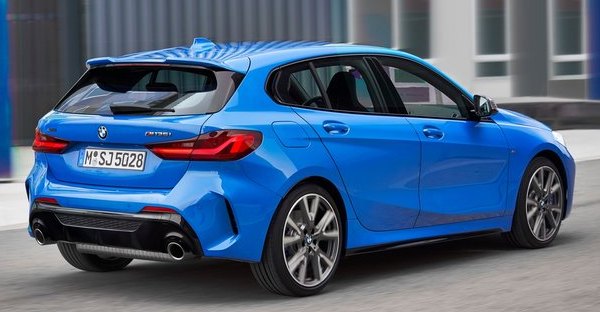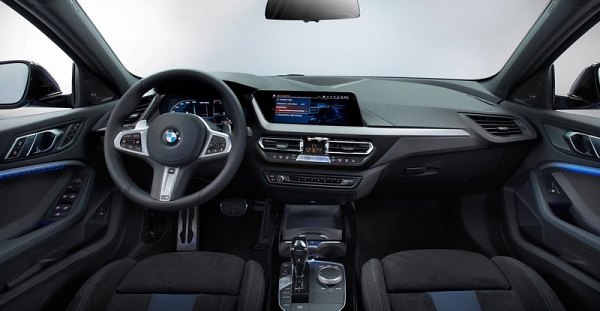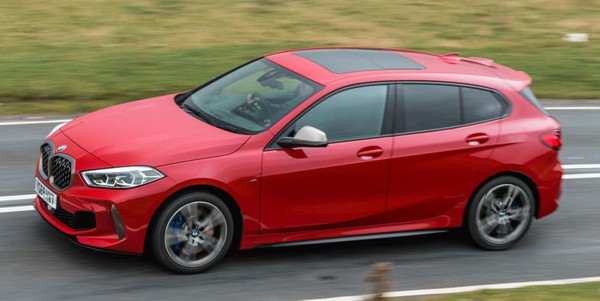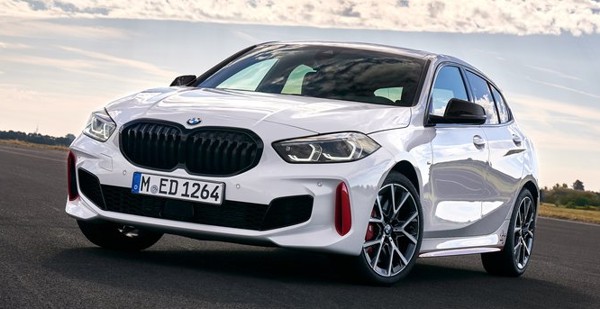Published
on 15
Feb 2020
|
All rights reserved.
|
|
|

|
|
The
1-Series finally switches to front-wheel drive to pursue packaging
advantage, but it is not necessarily poorer to drive...
|
|
We have been anticipating
the 1-Series to switch from rear to front-wheel drive architecture for
a few
years, and now the day finally arrives. The new 1-Series, codenamed
F40, is developed
based on the UKL2 platform that is already serving the 2-Series Active
Tourer, X1, X2, the China market 1-Series sedan, Mini Clubman and
Countryman. In addition to the closely related UKL1 (Mini hatchback),
BMW's FWD platform now achieves an annual output of more than 1 million
units, which is nearly half of the group's total. Adding the 1-Series
hatchback and the upcoming 2-Series coupe/cabriolet/gran coupe will
strengthen it further. Don't see BMW as an RWD brand anymore.
The F40 is again 5-door only. There are 2 different
styling, one for the regular models and another for M Sport trims. They
differ mainly in bumper design and grille color (M135i gets also mesh
treatment), though neither of them could be
called beautiful. Its larger, more angular version of double-kidney
grille might shout louder about its identity, but it is unlikely to
endure the test of time. Ditto the oddly shaped headlamps and the
complicated front bumper. Nevertheless, in terms of proportion, the new
car certainly looks more balanced than the old one. I have never been
fond of the old car’s styling. The need to package a longitudinal
straight-six into a compact family hatch body resulted in a very
strange
proportion. Having switched to transverse engine layout, the new
1-Series is finally freed from the old shape. Its front overhang is
extended, the front axle is relocated closer to the cabin, the
windscreen is set at faster angle and the bonnet gets more sloping.
This body looks more wind-cheating and more modern. However, it also
makes the baby BMW undistinguishable from mainstream family hatches on
the
market. Perhaps this is why Munich feels the need to use a larger
kidney grille.

|
|
M135i
loses 6-pot power but no performance...
|
|
Compared with the old car, the new one is no longer but 34mm wider and
13mm taller. Its wheelbase is shortened by 20mm to 2670mm, but thanks
to the shorter engine compartment, rear seat legroom is improved by
33mm. Rear headroom is also improved by 19mm. Well, considering how
cramped the old car’s back seat was, that is hardly a surprise.
Meanwhile, the boot gets 20 liters larger, now measuring a
class-competitive 380 liters. BMW claims the new chassis is stiffer,
while kerb weight is reduced by 30kg, thanks in part to aluminum bonnet
and tailgate. The suspension is predictably MacPherson struts up front
and multi-link setup at the rear (unlike some rivals which save costs
by using torsion-beam axle for lower power models). M Sport suspension
is stiffer and
mounted 10mm lower than the standard setup. Adaptive dampers are a
further option.
We no longer hear BMW claims 50:50 balance, but switching to UKL2 does
not mean the end of the world. There are plenty of very quick and
entertaining hot hatches on the market. Nothing stops BMW from matching
or beating them. It just depends on whether BMW can crack the code. The
new M135i is that car. Downgrading from the old M140i means replacing
the turbocharged 3-liter straight-six with a 2.0-liter turbo four –
isn’t it sound too familiar for the class? This engine has been used on
X2 and JCW version of Mini Clubman and Countryman. It produces 306
horsepower, exactly the same as rival Mercedes-AMG A35, but 332
pound-foot of torque beats anything in the class bar the fire-breathing
A45. Actually it is too torquey for BMW’s 6-speed manual gearbox, so it
comes with an 8-speed torque converter automatic. To put down the
power, the M135i gets not only a Torsen LSD at its front axle but also
xDrive as standard. The latter employs a Haldex-type multi-plate clutch
to engage the rear axle in case of need, so it is not a permanent 50:50
system. The M135i gets also extra bracings at the front structure and
tunnel area to reinforce the chassis, plus a quicker ratio steering
rack.
Other engines are already found on UKL2 cars, including a 1.5-liter
3-cylinder turbo diesel (116d, 116hp), a 1.5-liter 3-cylinder turbo
petrol (118i, 140hp) and a 2.0-liter 4-cylinder sequential twin-turbo
diesel (150hp for 118d or 190hp for 120d). BMW's modular 3 and
4-cylinder engines are generally
remarkable, delivering strong performance and flexibility yet good
refinement and outstanding economy. You can expect the same for these
motors.
However, if you look for a really super engine to rival A45 or RS3,
sorry, it is unlikely to happen. The M135i is as far as BMW plans to
offer.

|
|
Cabin
gets more stylish and higher in quality, but most welcomed is more rear
legroom.
|
|
If you are not sure about its exterior design, you can be relieved that
the interior looks and feels upmarket. It follows the design theme set
by the 8-Series coupe. The dashboard, center console and its
infotainment screen layout are all stylish and well finished. Materials
are premium, if not ultimately as premium as Mercedes A-class. The
optional TFT instrument looks advanced, although it is not
reconfigurable. The iDrive system is intuitive with its familiar
rotary control knob. Besides, it follows Mercedes to introduce a voice
recognition command control feature, thanks to tier-one suppliers. As
expected, the front seat and driving position on BMW is hard to fault.
Ergonomics are good, although the higher cowl position and the
disappearing bonnet are strange to BMW owners. Legroom at the rear seat
is certainly more generous than the old car
and comes close to match the class norm, although headroom is still
tight for tall occupants. Getting into the rear seat is also made
easier by the larger door aperture. All thanks to the switch to FWD
platform.
Is it more fun to drive than the old car? For cooking models, the
answer is definitely yes. Remember we criticized the old 1-Series for
soft suspension and an inert chassis? It was tuned to deliver safe
understeer at the limit and difficult to induce oversteer. The new car
has corrected the mistake. Its front end is a lot more locked down. The
front wheels generate remarkable grip and traction. The steering is
unusually quick and accurate, so the nose feels responsive and pointy.
No matter the standard suspension or M Sport suspension, it is firmer
than the old car's. This results in better body control. The ride
doesn’t
suffer too much, thanks in part to the stiffer chassis. On really sharp
bumps and pot holes it does send shockwaves into the cabin, but when
the roads get normal or as speed rises, it damps beautifully. Wind and
road noises are also well suppressed. Refinement is certainly much
improved. Ditto the driver appeal. Compared with other premium family
hatches, like A-class and Golf, the new 1-Series has an upper hand in
dynamics.

|
|
Most
surprising is a mobile rear end.
|
|
The M135i is also a good car. First of all, it is quick. While the
four-cylinder turbo engine is not as eager at the top end as that of
Honda Civic Type R (let alone the old straight-six), it still delivers
an elastic power that stretches
from very low to high revs. Working impeccably with the 8-speed
automatic and aided by 4-wheel traction, it is capable to sprint from
rest to 60 in merely 4.6 seconds. Do you miss the old straight-six?
Yes, you do miss the creamy smoothness as well as the musical sound,
but in the new world order of 4-cylinder power, the new engine is
pretty good. We just hope its exhaust note could be more characterful,
especially at the top end.
The M135i also rides and handles very good. Like the cooking models,
its steering is quick and precise, resulting in a razor-sharp turn-in.
Excellent front-end grip and Torsen differential keep the nose biting.
Although there are hints of torque steer when power out of corner, the
car doesn’t understeer. It doesn’t roll much either. Meanwhile, you
will be surprised to find out the multi-link rear end is more mobile.
Lift off throttle can induce oversteer, the nose tucks in and the rear
rotates. The xDrive offers remarkable traction but it works brilliantly
with torque vectoring (by brakes) and traction control to maintain
stability without ruining driver control. The new M135i feels more
lively than the old M140i as well as A35. It runs very close to the
Golf R, if no match for the Civic Type R for overall handling prowess,
control fineness and interaction. Unlike the old car, it is well
rounded, showing no major weaknesses. However, it is not the most
communicative or transparent hot hatch. The presence of torque steer
and the meaty but not feelsome steering are hard to love. The lack of
character is another. You can’t help thinking 20 years later we will
still remember the rear-drive M140i, but we will definitely forget this
M135i. Maybe in 5 years’ time.
|
Verdict:     |
Published
on 12
Feb 2021
|
All rights reserved.
|
|
128ti
|
|

|
|
BMW's
first front-wheel-drive hot hatch beats the mighty Golf GTI.
|
|
Until now, the new BMW
1-Series has a huge gap between its range-topping M135i xDrive and the
regular 120i. Think in this way: the former rivals Volkswagen Golf R
while the latter is an equivalent to the regular Golf 1.5TSI. How come
it misses the opportunity to steal sales from the volume Golf GTI? That
loophole is now amended by the introduction of 128ti.
The ti badge, stands for "Turismo Internazionale", was widely used in
the 02 series of the 1960s and last employed by the 3-series Compact.
It is a suitable nameplate for a BMW hot hatch that is not up to the
league of M-cars. The 128 name reflects also this performance
positioning. Power comes from the familiar B48 2.0-liter four-cylinder
turbo motor, rated at 265hp and 295 lbft here, which is 20hp and 22lbft
stronger than Golf GTI. It is good for 155 mph and 0-60 in 5.8 seconds,
beating its rival.
On the downside, the 128ti employs a mandatory 8-speed automatic
gearbox supplied by Aisin, leaving its drivers no way to enjoy manual
shifting and heel-and-toe driving. Moreover, while the Golf GTI employs
VAQ electronic variable LSD, the BMW settles with a passive Torsen LSD.
Nevertheless, BMW has introduced a sophisticated kind of traction
control called ARB, which is integral with the engine ECU so that it
can tame wheelspin 10 times quicker than conventional stability
control.
Compared with the M135i xDrive, losing the rear-axle drivetrain and
extra chassis bracings save 80 kg from its kerb weight, although 1445
kg (DIN) is still heavier than the class norm. The chassis tuning is
different from the M135i as well, and not necessarily milder. The
springs and dampers are stiffer than those of the top model. Toe-in is
reduced in all corners. The steering is made slightly slower for a more
linear manner. The LSD has its locking ratio reduced from 36 to 31
percent. You get the option of 19-inch wheels, but the stickiest
Michelin Pilot Sport 4S tires are available in only 18-inch, which is
good, because it doesn’t ruin ride comfort as much. However, inside the
18-inch alloy wheels are the same huge brakes from the M135i. With less
weight to stop, the smaller car should be superior in braking
performance.

|
|
More
playful, more involving hence more fun than the Golf GTI.
|
|
Like the M135i, the 128ti offers no adaptive dampers, which is another
area losing to Golf. Many modern BMWs need adaptive dampers to excel in
ride and handling, but not this car. Its suspension setup is perfectly
judged. The ride is a little harsh below 30 mph, but once up to speed,
it flows with poise and composure. It soaks up the bumps on B-roads yet
has its body tightly controlled. It turns in eagerly. The retuned
steering is more intuitive than that of the M135i, offering a clearer
sense of connection to the front wheels, although not quite as feelsome
as Honda Type R, of course. The nose bites hard, refusing to
understeer. Plant the throttle in a tight corner, you will sense some
torque steer, and the Torsen LSD could hesitate a while before taming
the wheelspin. It might not be as effective an A-to-B car than the Type
R, Megane RS or even Hyundai i30N, but it beats them clearly in ride
and refinement, because it aims at the Golf GTI rather than those
hardcore hatchbacks. What’s surprising is, it is more prone to throttle
steer than the Golf, if not as much as Focus ST. Lift off mid-corner
will tuck its nose in. Bury the throttle again and counterlock the
steering will kick its tail out for a smooth slide. So the 128ti is
more playful, more involving hence more fun than the Golf GTI.
The powertrain might not be memorable, but powerful enough, refined and
simultaneously frugal. Well, you lose the chance to enjoy shifting
yourself, but the Aisin automatic is mostly smooth and responsive.
What impresses most is the all-round package. Golf GTI used to be the
only hot hatch that blends performance, handling, comfort, usability
and build quality at a reasonable price. Now its position is taken up
by the new BMW. While the Golf has its interior materials downgraded in
the recent makeover, the 1-Series has taken a giant step forward,
offering premium quality materials, classy design and ergonomics that
puts the VW in shame. The hardware controls and the software design of
its i-Drive system are so much easier to use than the Volkswagen’s
touchscreen infotainment system. Yet, the 128ti is priced at
£33,000, undercutting its German rival. BMW’s first attempt at
the front-wheel-drive hot hatch segment is amazing. The only
reservation is styling: just make sure you are okay with its face.
|
Verdict:     |
|